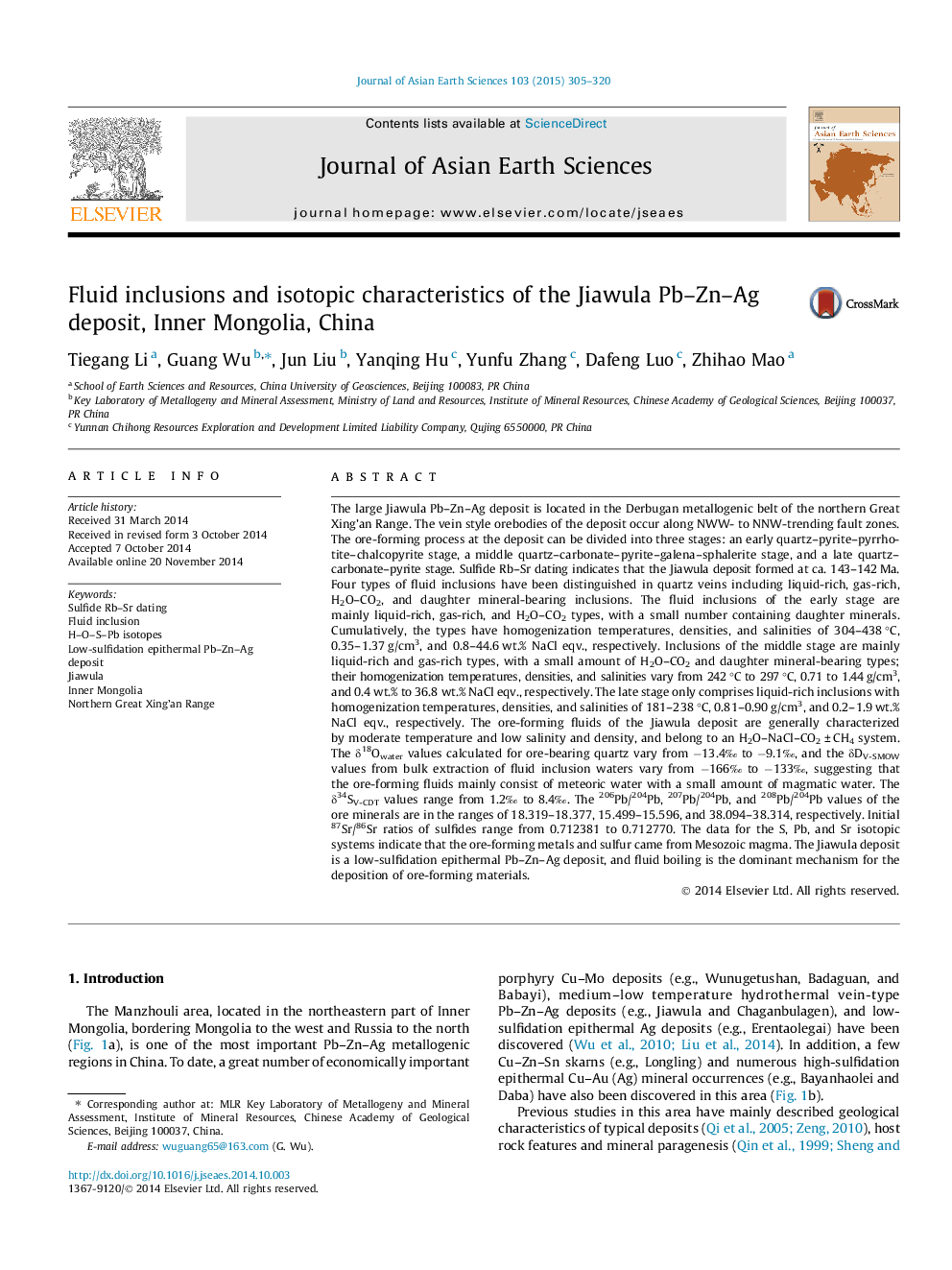| کد مقاله | کد نشریه | سال انتشار | مقاله انگلیسی | نسخه تمام متن |
|---|---|---|---|---|
| 4730364 | 1640366 | 2015 | 16 صفحه PDF | دانلود رایگان |

• The sulfide Rb–Sr isochron age of the Jiawula deposit is ca. 143–142 Ma.
• The ore-forming fluids are medium–low temperature and variable salinity fluids.
• The ore-forming fluids are mainly meteoric water with minor magmatic water.
• The ore-forming materials mainly came from the Mesozoic magma.
• The deposit is a low-sulfidation epithermal Pb–Zn–Ag deposit.
The large Jiawula Pb–Zn–Ag deposit is located in the Derbugan metallogenic belt of the northern Great Xing’an Range. The vein style orebodies of the deposit occur along NWW- to NNW-trending fault zones. The ore-forming process at the deposit can be divided into three stages: an early quartz–pyrite–pyrrhotite–chalcopyrite stage, a middle quartz–carbonate–pyrite–galena–sphalerite stage, and a late quartz–carbonate–pyrite stage. Sulfide Rb–Sr dating indicates that the Jiawula deposit formed at ca. 143–142 Ma. Four types of fluid inclusions have been distinguished in quartz veins including liquid-rich, gas-rich, H2O–CO2, and daughter mineral-bearing inclusions. The fluid inclusions of the early stage are mainly liquid-rich, gas-rich, and H2O–CO2 types, with a small number containing daughter minerals. Cumulatively, the types have homogenization temperatures, densities, and salinities of 304–438 °C, 0.35–1.37 g/cm3, and 0.8–44.6 wt.% NaCl eqv., respectively. Inclusions of the middle stage are mainly liquid-rich and gas-rich types, with a small amount of H2O–CO2 and daughter mineral-bearing types; their homogenization temperatures, densities, and salinities vary from 242 °C to 297 °C, 0.71 to 1.44 g/cm3, and 0.4 wt.% to 36.8 wt.% NaCl eqv., respectively. The late stage only comprises liquid-rich inclusions with homogenization temperatures, densities, and salinities of 181–238 °C, 0.81–0.90 g/cm3, and 0.2–1.9 wt.% NaCl eqv., respectively. The ore-forming fluids of the Jiawula deposit are generally characterized by moderate temperature and low salinity and density, and belong to an H2O–NaCl–CO2 ± CH4 system. The δ18Owater values calculated for ore-bearing quartz vary from −13.4‰ to −9.1‰, and the δDV-SMOW values from bulk extraction of fluid inclusion waters vary from −166‰ to −133‰, suggesting that the ore-forming fluids mainly consist of meteoric water with a small amount of magmatic water. The δ34SV-CDT values range from 1.2‰ to 8.4‰. The 206Pb/204Pb, 207Pb/204Pb, and 208Pb/204Pb values of the ore minerals are in the ranges of 18.319–18.377, 15.499–15.596, and 38.094–38.314, respectively. Initial 87Sr/86Sr ratios of sulfides range from 0.712381 to 0.712770. The data for the S, Pb, and Sr isotopic systems indicate that the ore-forming metals and sulfur came from Mesozoic magma. The Jiawula deposit is a low-sulfidation epithermal Pb–Zn–Ag deposit, and fluid boiling is the dominant mechanism for the deposition of ore-forming materials.
Journal: Journal of Asian Earth Sciences - Volume 103, 1 May 2015, Pages 305–320